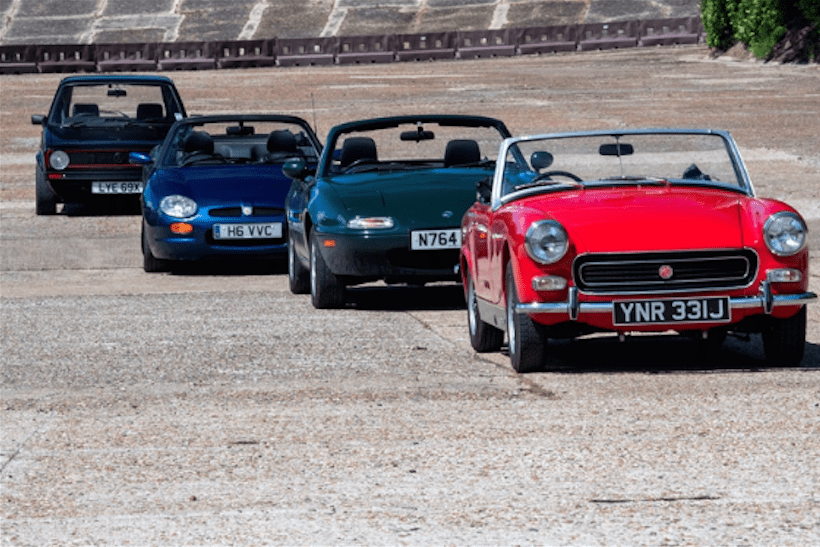From its golden age in the 1960s, the traditional sports car seemed to be killed off by the rise of the hot hatchback in the 1970s. Then the breed rose from the ashes in the 1980s to be one of the motoring hits of the 1990s. We spend the day with an MG Midget, VW Golf GTI Mk1, Mazda MX-5 Mk1 and MGF to see how they compare and how they differ.
11:00 – Bewl Water, Kent
The first challenge of the day is actually finding the starting point – our sat nav was determined to take us to the literal middle of the reservoir, and the MGF is not amphibious. Our first approach was on the East Sussex side, and had we known where to look we could probably have seen a concerned group standing around a Volkswagen Golf and looking at their watches half a mile away on the Kent side. The brisk drive along the back roads in company with CCB staffer Matt Bell in the Mazda MX-5 to reach the meeting point was certainly a good chance to get acquainted with this particular ‘F – a Mk1 VVC which has had its original Hydragas suspension swapped for a coil kit.

Where it begins, Bewl Water. MX-5 and MGF takes on the original hot-hatch king, the Mk1 Golf GTI.
With its racy engine zinging out 142 horsepower, a nearly flat torque curve and a very easily-reached redline at 7000rpm, plus those newly-acquired sharper coil-sprung dynamics, the MG has the makings of a great sports car. Unfortunately they’re hard to get at it because all the controls feel remote and inert. The electric power steering lacks feel and what weight there is is static and artificial. The brakes don’t match the car’s pace, the clutch has no discernible biting point and the gearchange needs a slow, steady pressure that will still lead to a baulk three times out of ten. It’s frustrating to be accelerating hard to keep up with a green MX-5 disappearing into the distance and find yourself floundering around in neutral trying to find third. If it wasn’t for the good ‘seat of the pants’ feel and its sheer speed this MGF would be almost boring to drive. It can cover ground, even twisty derestricted A-road ground, without breaking pace or sweat but you come to find that out by experience rather than intuition.
13:00 – Denbies Wine Estate, Surrey
Having sat out in the sun for four hours and being a black car with no sunroof the Mk1 Golf was very literally a hot hatchback when I stepped in. For a moment, encased in the finest black plastic and synthetic cloth the 1970s had to offer, I was jealous of those in the roof-down convertibles.

The original hot-hatch hero, the Mk1 Golf GTI. Better than a modern sports car?
But that envy quickly vanished on the sprint between Bewl Water and the Denbies Wine Estate – 30 miles of dual-carriageway, old sections of the vintage A25 through the Surrey hills and then a blast round the bottom section of the M25. This is the sort of road that a first-gen hot hatch was built for. The Golf is the loudest of the quartet, with a nice gargly exhaust note. The VW’s overhead cam engine was never the most exciting power unit on offer but it’s punchy, smooth and feels nicely unburstable. From a modern perspective it’s hard to believe that 1.6-litre hatchback with 108bhp was ever seen as driving nirvana but the Golf is light and, much more importantly, very communicative in all the ways that the faster, more high-tech MGF was not.
The basics are all there. With its wide wheels at each corner and front-wheel drive on hot, dry roads the Golf feels like one of those Scalextric cars with a magnet in the bottom. Even just cruising along at 50mph or so on the A25 is enjoyable because of the way the VW flows from corner to corner, letting you enjoy the way the unassisted steering (responsive but never twitchy) gradually loads up as you turn in. Sometimes you’ll have to ease off as the car in front slows or turns into a junction, but that’s just an excuse to drop a gear and enjoy the sound and feel of the lusty engine under the blunt bonnet.
Of course the Golf really shone on the M25 – instead of being buffeted by wind and fumigated by diesel exhaust, the VW driver can enjoy just being in what becomes an ordinary car. Albeit a rather loud one which jolts over the joints in the concrete but it’s still way more refined than a traditional sports car and if the weather was more typically British, or we were travelling more than two-up, or had luggage, then the Golf’s hatchback body would come into its own. It would certainly be the car of choice if we were going to be taking home any of the produce from our first stop-over in this strange corner of Surrey which appears to have been teleported in from Provence, complete with cloudless blue skies, heat haze, rows of vines in dusty earth and avenues of plane trees lining the roads.

Humble beginnings. The MG Midget looks as beautiful today as it did over 50 years ago.
14:30 – Epsom Downs Racecourse
It was time to split the difference age-wise between the VW and the MG for the next leg (our convoy now including a red MG Midget) by getting behind the wheel of the Mk1 Mazda MX-5 – the car which proved that the sports car was not dead but merely resting. This one from Mazda’s press fleet is a straightforward 1.8-litre model.
It was seven miles to our next stop, Epsom Downs, which calls itself the ‘Home of British Racing’ and is concerned with horsepower of a more literal sort. It was a jaunt along a bit more sweeping dual carriageway, some suburban town roads through Ashtead and then a brief but very pretty rural plunge down through Langley Vale and up onto the Downs – certainly enough to get the measure of the Mazda. The passing of the years hasn’t diminished how absolutely ‘right’ the original MX-5 feels from the moment you let the clutch up. It is the platonic ideal of the sports car, with a fore/aft drivetrain all set nicely within the wheelbase giving perfect weight distribution, fully independent suspension and as little weight as possible. That it’s much slower than the MGF and barely quicker than the Golf doesn’t really matter.
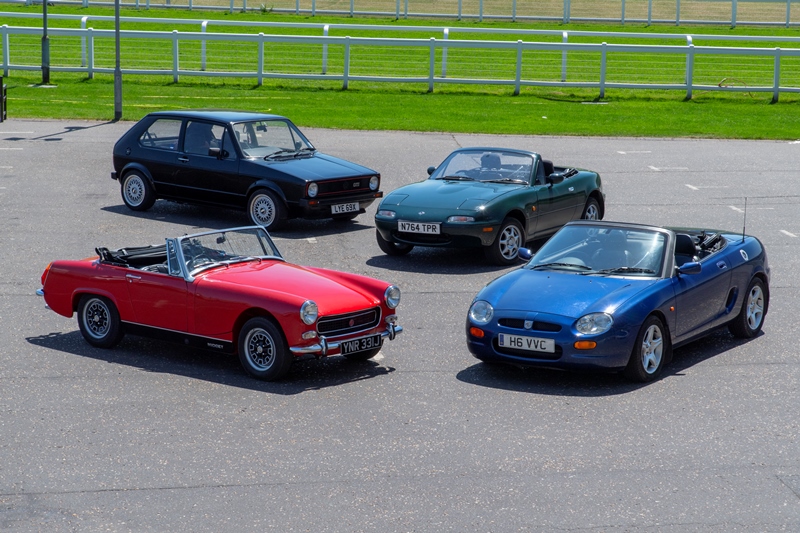
Sports cars looming over the hot-hatch
Even at modest speeds the MX-5 feels poised, as if in dynamic terms its sitting on a pivot. The hot hatch and the MG felt planted and grippy but you can feel the MX-5 shifting its weight on its springs and each corner loading or unloading as you drive. It’s too well resolved and docile to unexpectedly turn on you but there’s a definite sense that if you pushed it hard and deliberately it could do proper classic sports car-type oversteer. This makes it very enjoyable to thread the MX-5 along a road, especially that all-too-brief blast down Langley Vale. The engine lacks the punch of the other two engines, really needing to be worked into its upper reaches to get the maximum performance out of the Mazda, especially on hills, but that makes it easy to exploit the full rev range and the lower gears while staying well within the legal limits – something which the tall-geared and long-legged MGF cannot do. Even shunting along in dawdling traffic it’s nice to just sit in the snug cockpit with the roof down and flick between second and third gear, the gearshift being so short and slick that you really just have to flex your fingers rather than move your arm. Being designed expressly for the road rather than the track.
16:00 – Brooklands Museum
Time to travel all the way back into history with the MG Midget as we head of to the home of British motorsport at Brooklands. It was here in the 1920s that the Midget and MGF’s octagon-badged ancestors won their spurs as thoroughbred sports cars before Volkswagen even existed and when Mazda was still making artificial cork products.
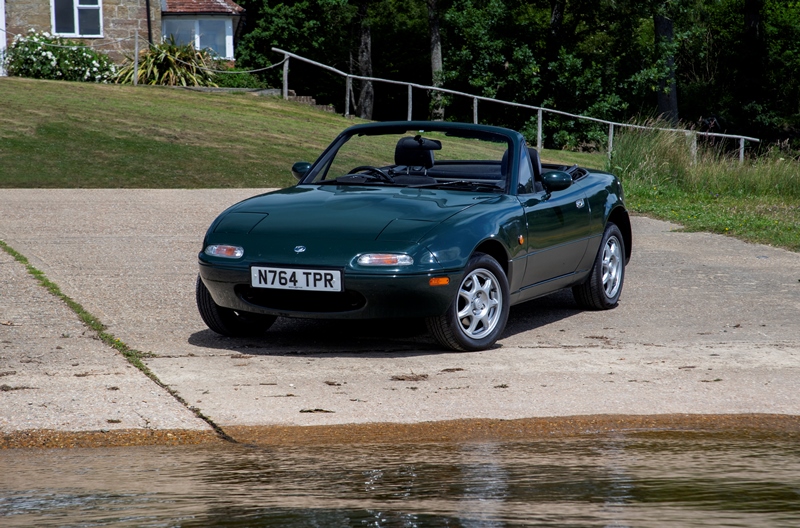
The car that transformed the sports car market, the Mazda MX-5 Mk1
I had previously been struck with how small the Golf looked in modern traffic but the Midget (as the name implies, a small car even by 1960s standards) is positively microscopic. Lowering yourself into the sparse crackle-painted cockpit with its painfully gleaming chrome dial bezels isn’t the most elegant procedure but once you’re in its surprisingly comfy even if it’s not spacious and, like the Mazda, the controls are all where you want them even if the steering wheels seems somewhat oversized.
You can definitely sense the spiritual link between Midget and MX-5 – Mazda were consciously trying to recreate the stripped-out, low-performance, high-fun feel of cars like the Midget and driving the two back to back you see how they succeeded. The Midget’s performance stats are pointless because that’s not what the MG was ever about. It’s about savouring the experience of driving rather than getting it over with as quickly as possible. The low-slung Midget, the way you’re pressed against the door and the near-total lack of bodywork above chest height makes it feel much faster than it actually is, helped by the very low gearing which means the willing 1.3-litre engine is growling away well up its rev range even at low speeds. Quick steering needs pressure more than movement in your arms once you’re rolling above 10mph or so and the gear lever snicks between speeds with a lovely precision-made feel. The engine snorts under acceleration and crackles on lift-off. Even trundling along the road between Epsom and Oxshott at 40mph the Midget feels exciting, let alone the adrenaline rush of joining the A3 when the sidewalls of lorries tower over you. The downside is that the Midget’s ride, especially with both seats filled and some baggage, is very bumpy, the actual amount of grip available is very low and the top comfortable cruising speed is no more than 60mph (which feels and sounds like 100). But for purity of the experience, the MG knocks all the others into the next county.

Trying to decide which one is best. None of us agreed…
17:00 – The A1
The day came full circle as I took the MGF back up to Peterborough, giving me a chance to rank the four driving enthusiast’s cars from four decades. As ever, it comes down to the divide in personal taste between performance and involvement.
Let’s work chronologically. The Midget has character and charm bursting from every body seam, and if your idea of a sports car is one with chrome bumpers and carburettors then it’s the only choice. It’s the one that requires the most effort to drive and therefore is also the most rewarding. But it also makes the fewest compromises – it’s a toy with no concessions to comfort or practicality. It’s cramped, it’s slow, it’s bouncy and it’s certainly not that fast. You may tire of continually being outrun by delivery vans. But it’s the car that’s the most outright fun for all those objective flaws.
The Golf GTI is thrown into sharper relief by the comparison with the Midget, because it offers much of the same experience but in a larger, faster and more practical package. To say it’s not as engaging as the Midget is unfair because by any other standard it’s a hugely enjoyable car to drive and unlike the little MG it can happily do the daily grind when it’s being just a hatchback rather than a hot one. The GTI is actually quick rather than merely giving the illusion of it and you can easily see why the hot hatch became the equipment of choice for driving enthusiasts tired of the traditional offerings with their mechanical parts taken from 1950s saloon cars.
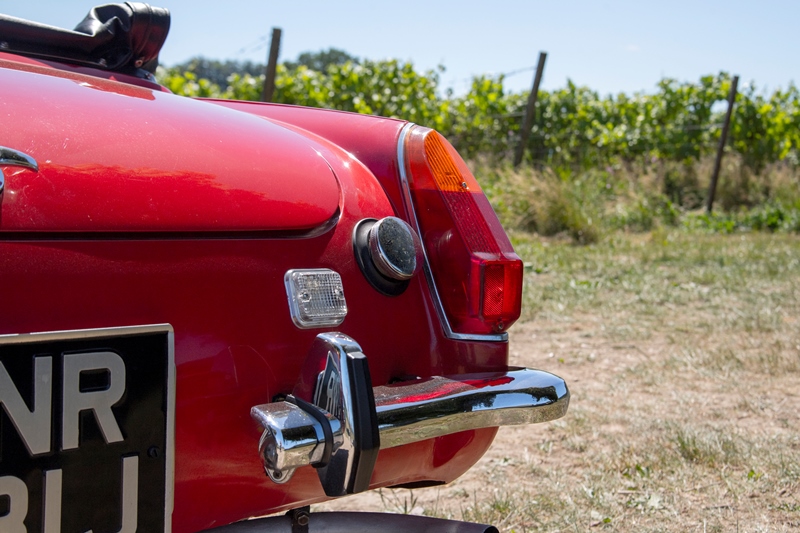
The MX-5 combines the feel and fun of the Midget with the reliability and refinement of the Golf. It lack’s the VW’s practicality, of course but here is a machine which manages to sand the rough edges off the classic sports car experience without detracting too much from the essential character. It’s hard to say any more than that because that has always been the key to the MX-5’s unique success – it is a classic sports car with no downsides. With twice as much power as the Midget and more sophisticated suspension the MX-5 offers genuine, but still very useable, performance to go with its well-sorted dynamics and haptic controls.
The MGF is a sports car for the Playstation generation, with its electric power steering and mid-mounted engine with clever valve timing. There is no complaining about the MG’s performance, which is astonishingly good. Under the rubbery gearchange, numb clutch and lifeless steering there is also a very capable, grippy and at times playful chassis but there’s always that sense of passing instructions to the parts rather than connecting with the car. Learn the car’s capabilities by experience (rather than intuition, as in the other three) and it can do great things. But I’d happily sacrifice that extra pace for the added tactility of the Mazda.
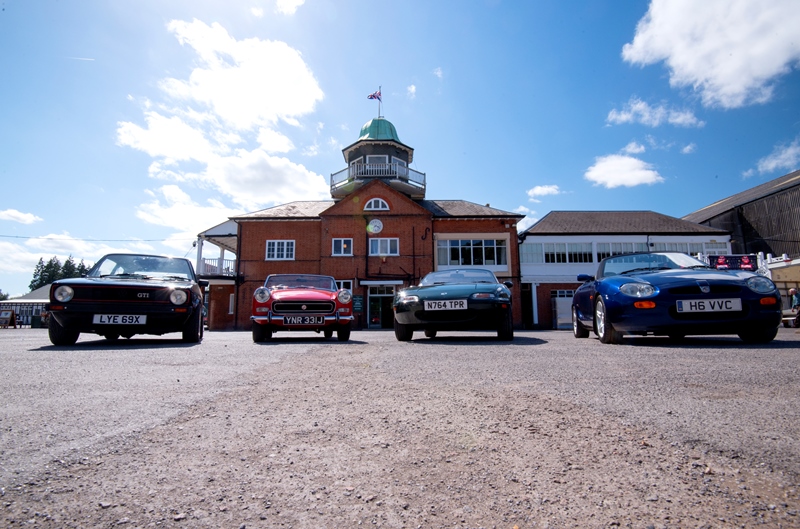
Is there a more fitting end to a road trip in the UK than Brooklands Museum?

